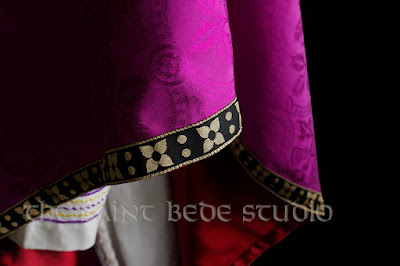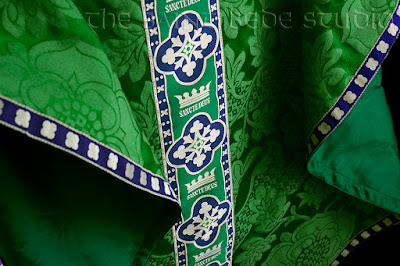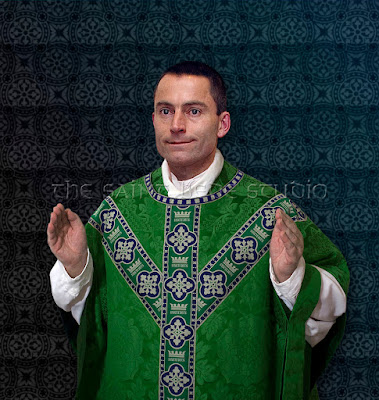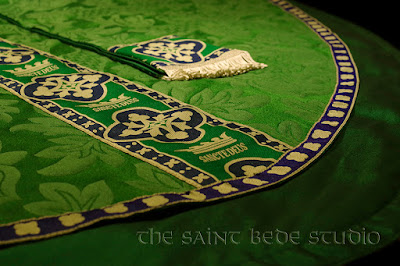In the twelfth century, Pope Innocent III was the first to specify the colours of the vestments that were to be used for the Roman Rite; almost certainly this reflected prevailing custom in Rome, not an invention on his part. Although a separate subject from this article, it is well to remember that it was only towards the end of the 1st Millenium that the question of vestment colour became a significant one. Black was designated for penitential and funeral liturgies, but violaceus was indicated as a substitute for black. Pope Innocent’s treatise De sacro altaris mysterio (Book I, chapter 65, which was written before his election as pope in 1198) seems to be the first indication that violaceus had come to be regarded as a penitential colour for the Roman Rite.
If the Royal Purple colour - which emerged in Late Antiquity Europe as a substitute for Tyrian Purple - incorporated what Innocent III refers to as violaceus how did it come to be regarded as a colour of Penance rather than Status? The answer to that is not clear. Extensive research is needed into how the word violaceus was used in Late Antiquity. We do know that the flowers we know as violets were known in antiquity and that the words viola and violarium described the flower, violaceus being an adjective derived from those nouns.
So, what colour is indicated by Innocent’s use of the word violaceus? Let’s consider that question differently: not what the colour was, but what process was used to produce the colour.
 It is likely that at this time (12th century) Tyrian or Imperial purple was still being used in Rome, but it had become the colour used exclusively by the Pope and by nobility. So, when Innocent used the word violaceus (instead of purpura), it would seem very unlikely that he was recommending that violaceus-coloured vestments were to be dyed from the expensive process for producing Tyrian purple. That expensive process would be unaffordable and unavailable to Western clergy. Rather, it would seem likely that Innocent’s violaceus was intended as Royal purple, a colour produced from the less expensive non-Murex dyes. It should be carefully noted that these less expensive dyeing processes could produce a violet coloured dye or an amethyst (or fuchsia) purple coloured dye. But they were colours not so dark as Tyrian purple. I would suggest, therefore, that Innocent’s use of the word violaceus has nothing to do with an attempt to make a distinction (as some scholars have suggested) between the colours we recognise as violet and purple.
It is likely that at this time (12th century) Tyrian or Imperial purple was still being used in Rome, but it had become the colour used exclusively by the Pope and by nobility. So, when Innocent used the word violaceus (instead of purpura), it would seem very unlikely that he was recommending that violaceus-coloured vestments were to be dyed from the expensive process for producing Tyrian purple. That expensive process would be unaffordable and unavailable to Western clergy. Rather, it would seem likely that Innocent’s violaceus was intended as Royal purple, a colour produced from the less expensive non-Murex dyes. It should be carefully noted that these less expensive dyeing processes could produce a violet coloured dye or an amethyst (or fuchsia) purple coloured dye. But they were colours not so dark as Tyrian purple. I would suggest, therefore, that Innocent’s use of the word violaceus has nothing to do with an attempt to make a distinction (as some scholars have suggested) between the colours we recognise as violet and purple. Whilst I suggest that it is an error to interpret Innocent’s violaceus as intending only the colour violet as we recognise it today, it should also be noted that his treatise in a separate section (Chapter 32) discusses the use of the Mosaic colours (cf Exodus 28:5), namely, scarlet, flax-gold, blue and purple, the latter which Innocent describes as signifying the authority and royal dignity of a bishop. In short, purpura still had the connotation of prestige in the time of Innocent III (quite distinct from a penitential use).
I would add that it is certain that Innocent’s violaceus was not the dark violet-blue colour indigo which is commonly understood today as liturgical violet. Indigo, an ancient colour, was a blue quite distinct from violet or amethyst purple. Furthermore, it was not a commonly-used colour in Europe until the 16th century, when it came to be imported from India (hence the name Indigo).
After the fall of Constantinople in 1453, the supply of the Murex shell to produce Tyrian purple dye disappeared. So, in 1464 Pope Paul II authorised an alternative method of production of purple dye, extracted from the cochineal insect. Some scholars have suggested that the purple of the cochineal was much closer in hue to what we call purple and led to our modern conception of purple being a mixture of red and blue. As we have seen, the “purple” Tyrian was dark crimson because of double-dyeing. Others have suggested that Paul II's colour was closer to what we know as the scarlet used by Cardinals. Further investigation of this is required.
 Even after Paul II’s introduction of the new process for dyeing, the colours violet and purple continued to be interchanged indiscriminately throughout the Western church for penitential vestments and the robes of bishops up until the 19th century. The 17th century painting of the prelate Ottaviano Prati shows that his vesture is of violet rather than the fuchsia-purple that we are now familiar with.
Even after Paul II’s introduction of the new process for dyeing, the colours violet and purple continued to be interchanged indiscriminately throughout the Western church for penitential vestments and the robes of bishops up until the 19th century. The 17th century painting of the prelate Ottaviano Prati shows that his vesture is of violet rather than the fuchsia-purple that we are now familiar with.From the 19th century, as the process of dyeing fabric became more refined, that shade which the Church designated “purple” became more specific. Even so (as mentioned in Part One of the article), it was not until 1933 that Rome specified the shade of purple that was to be used for the robes of its prelates.
A darker version of violet – closer to Indigo – became more common in Europe in the 19th century and soon crept into the usage of the Church. Rome resisted this innovation until after the Vatican Council, but we have seen Popes over the last 50 years wearing this Indigo-colour during Lent: a dark colour to reflect a penitential mood.
To conclude, a little summary. The word violaceus used in the ceremonial books of the Roman Rite indicates the colour purple (reddish hues) or violet (bluish hues): the Church does not define the shade violaceus as it applies to sacred vestments. But the Church does define the shade violaceus for the robes of its prelates. Both the reddish purple and the bluish “purple” are colours that have been traditionally used for sacred vestments in the Roman Rite since at least the 12th century. There is a well-established usage in the Church’s Traditions for (1) Tyrian purple, (2) violet and (3) amethyst purple (or fuchsia). But of all the shades of “violaceus” currently in use throughout the Roman Rite, Indigo or dark violet has the least claim to Tradition.
 The ceremonial books of the Roman Rite make no distinction between the shade of violaceus for the vestments that are to be worn in Advent, Lent or for funerals. On the other hand, those books do not prohibit variations, which might enhance symbolism in a particular Season. In other words, the one shade of “violaceus” is not required to be used for Lent, Advent and for Funerals. In more recent years, for example, the Pope has worn indigo-violet in Lent and purple in Advent. In the United States, some liturgists advocate the opposite practice. In Australia, the colour of the violet flower is used in many dioceses for Advent. Since the Church gives latitude on these matters, we are on safe ground when we choose these shades for liturgical use. We are not on safe ground, however, when we insist that a particular shade is the colour that the Church intends. The history of the use of these colours reveals that they were used freely, without specific regulation, right up until our own times.
The ceremonial books of the Roman Rite make no distinction between the shade of violaceus for the vestments that are to be worn in Advent, Lent or for funerals. On the other hand, those books do not prohibit variations, which might enhance symbolism in a particular Season. In other words, the one shade of “violaceus” is not required to be used for Lent, Advent and for Funerals. In more recent years, for example, the Pope has worn indigo-violet in Lent and purple in Advent. In the United States, some liturgists advocate the opposite practice. In Australia, the colour of the violet flower is used in many dioceses for Advent. Since the Church gives latitude on these matters, we are on safe ground when we choose these shades for liturgical use. We are not on safe ground, however, when we insist that a particular shade is the colour that the Church intends. The history of the use of these colours reveals that they were used freely, without specific regulation, right up until our own times.Some views of my own on these matters, and they are no more than that: views.
For the Ordinary form of the Roman Rite, when red vestments are required to be used for Palm Sunday and Good Friday, I would like to suggest that it is perfectly permissible and even desirable to use that blood red colour which the ancients referred to as Tyrian Purple. Dare I suggest that this purple is also the appropriate colour for Palm Sunday and Good Friday in the Usus Antiquior of the Roman Rite? I risk being accused of archaeologism, of course.
Then, there is the Season in the Usus Antiquior of the Roman Rite called “Septuagesima”. Is it desirable that the importance of the Season of Lent (from Ash Wednesday onward) be enhanced by the use of vestments of a different colour from the colour used in Septuagesima? We know this is the case in the Sarum and other uses, where a special “Lenten Array” of unbleached linen was used specifically for Lent.
I would like to acknowledge assistance from Inge Boesken Kanold and Dr Gerhard Steigerwald, scholars of the history of the colour purple, in the preparation of this article.












